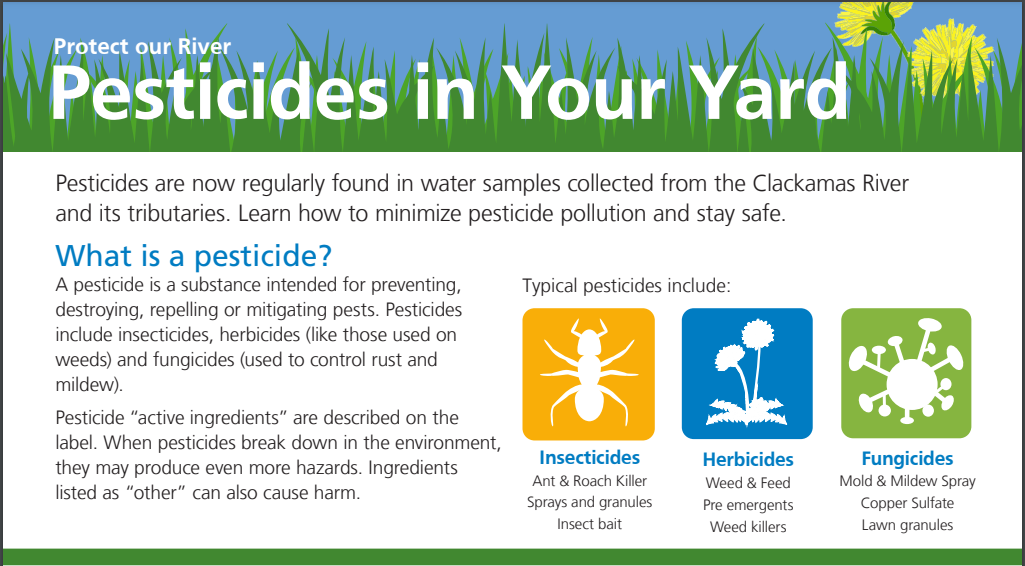Resources on how you can reduce pesticides
Thank you for your interest in our pesticide reduction efforts! With your help, we can cut back on the amount of chemicals used in our lawns and gardens, which is a growing concern in our watershed. A multi-year study released by the US Geological Survey (see below) emphasizes the increasing presence of pesticides in the Clackamas River basin.
Residential pesticide use is on the rise — every year, American homeowners apply over 90 million pounds of chemicals to their lawns and gardens. That’s equivalent to the weight of over 5000 school buses! Unfortunately, these chemicals often end up affecting plants and animals that aren’t the intended target. Sensitive salmon are especially hard hit.

Parting with Pesticides
We all need to work together to ensure the health of our watershed by using chemicals wisely and sparingly. Pesticides have been found in water samples collected from the Clackamas River and its tributaries. Take the Pesticide Pledge now!

Pesticide Fact Sheets
For your convenience, we have created helpful pesticide fact sheets with information on how you can reduce your pesticide use. Please visit our Pesticide Fact Sheet page using the button below. Thank you to the Clackamas River Water Providers and the Oregon Departments of Agriculture and Environmental Quality for support of these fact sheets. Lets keep chemicals out of our waterways!
Reduce the need for pesticides with strategic plant choices
Choose Wisely: Right-Plant, Right-Place!
Planting native plants in the right place based on site characteristics such as light, water, and soil requirements reduces the need for pesticides, watering, and lessens the chance of plant mortality. If you design your landscape, garden, or streambank planting in a way that promotes water conservation, it can be both economical and environmentally friendly. Keeping plants from competing for shade and water means happy plants!
Tips for choosing the right plant for the right place:
- Plant native plants (trees, shrubs, groundcovers, or perennials) that can tolerate both wetter and drier conditions
- Use drought tolerant plants (called xeriscaping) as well as disease and pest resistant plants (healthy natives!) to reduce the need for water, pesticides, herbicides, and fertilizers
- Choose plants adapted to the region’s soil and climate (generally those native to Mediterranean climates, referencing the Pacific Northwest, and suitable for Western Oregon) and plant during the rainy season
- Know your seed zones and select planting stock from a local seed source with genetically diverse seedlings
- Assess current site conditions such as poorly drained areas (flooding), compacted soil, erosion issues, abundance and types of weeds growing, intensity and duration of sunlight and shade, humidity, and wind direction to reduce failed plantings
- Group plants in the same area based on water needs (called hydrozoning) to conserve water
- Observe what plants are already thriving on site (often these plants are doing well for a reason) and encourage natural regeneration of these species
- Prevent runoff by utilizing plants that can get their “feet” wet, which will soak up and slow delivery of water to stormwater drains and into streams
- Install ecolawns, bioswales, or raingardens as alternatives to traditional landscapes
Visit these resources for more information:
NORTH WILLAMETTE RESEARCH AND EXTENSION SERVICE
- WATERWISE GARDENING COURSES
- A GUIDE TO RIPARIAN TREE AND SHRUB PLANTING IN THE WILLAMETTE VALLEY: STEPS TO SUCCESS (PDF)
- SELECTING NATIVE PLANT MATERIALS FOR RESTORATION PROJECTS (PDF)
CONSERVING WATER IN THE GARDEN: DESIGNING AND INSTALLING A NEW LANDSCAPE (PDF)
OREGON SEA GRANT – THE OREGON RAIN GARDEN GUIDE: LANDSCAPING FOR CLEAN WATER AND HEALTHY STREAMS
CLACKAMAS SOIL AND WATER CONSERVATION DISTRICT – RESOURCES YOU MANAGE
SUNSET MAGAZINE – CLIMATE ZONES: WESTERN OREGON
Pesticide Occurrence and Distribution in the Lower Clackamas River Basin
PESTICIDE OCCURRENCE AND DISTRIBUTION IN THE LOWER CLACKAMAS RIVER BASIN, OREGON, 2000–2005
A study performed by the U.S. Geological Survey (USGS), in conjunction with the Clackamas Watershed Management Group, found a variety of pesticides present within the Clackamas watershed. From 2000 to 2005, water samples were collected from various locations on the lower Clackamas River main stem, as well as Eagle, Clear, Deep, Richardson, Rock, Sieben, Carli, and Cow Creeks. A total of 119 samples were analyzed, detecting the presence of 63 different pesticide compounds. Ninety-seven percent of samples collected from tributaries contained 2 or more types of pesticides, and the highest pesticide concentrations were found in Deep and Rock Creeks. Seven of the 8 tributaries sampled had pesticide levels that exceeded standards set to protect aquatic life. And, although the current levels of pesticides are well below US EPA drinking water benchmarks and other human health standards, they serve as a warning sign that the health of our waterways is threatened.
The pesticides detected in the Clackamas River watershed come from an variety of different sources. The exact source is hard to pinpoint because many pesticides have multiple uses, but common applications include nursery and floriculture crops, yards, golf courses, parks, forestlands, and along fences, roads, and other right-of-ways.
Often, pesticides are applied in residential areas to control weeds and insects in lawns and gardens, and in houses to kill pests, such as ants and fleas. One of the most frequently detected pesticides in the USGS study was glyphosate, the active ingredient in many urban, agricultural, and forestry herbicide products, including RoundUP™, Rodeo™, and Accord™.